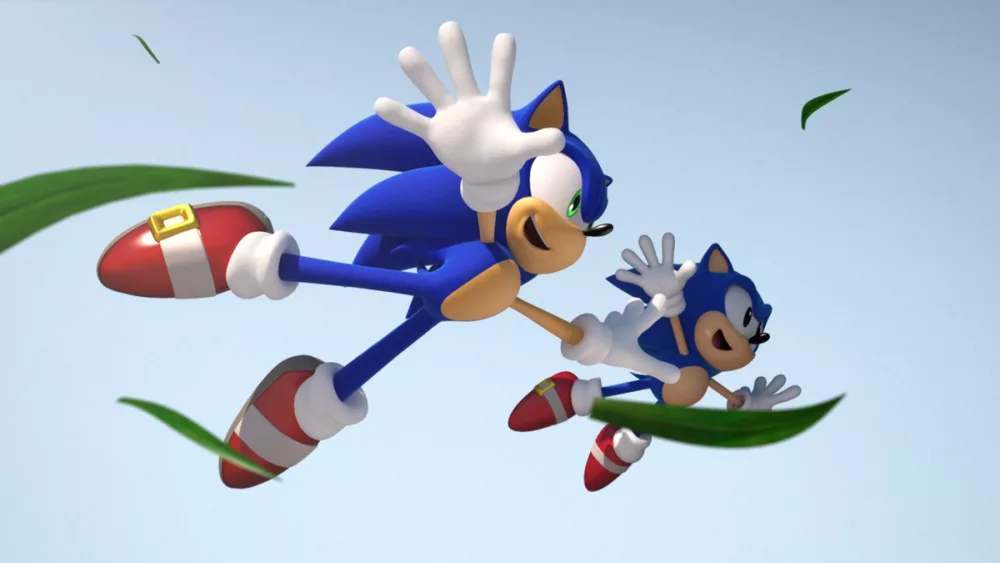
Sonic the Hedgehog and his friends aren’t just characters slapped onto arcade boxes. Sonic’s a gaming icon, and you’d be hard-pressed to find someone who hasn’t heard of him. But what’s the scoop behind this legendary character known today across the world?
Back when Sega was butting heads with Nintendo, characters were mostly just placeholders, interchangeable and forgettable. But then came a shift—a dumping of the tired, uninspiring avatars for someone who could stand shoulder to shoulder with the likes of Mario.
Enter Sonic the Hedgehog.
Designed to be more than just pixels on the screen, Sonic was Sega’s ace. His creation marked a serious tactical play to dominate the ’90s gaming scene. Few could animate a character like the sleek hedgehog who would go on to embody speed, strategy, and that certain rebellious edge.
Creating Sonic involved some serious brainstorming by Sega. Faced with the challenge to match Mickey Mouse’s iconic status, the design was meant to be simple yet so effortlessly cool. They brought in ideas from various inspirations like cartoons.
So, when the Sega Genesis made its rounds, it wasn’t just another console and Sonic wasn’t just a competitor; he was the game changer. His image, electric blue like Sega’s logo, was the shot in the arm Sega needed to go toe-to-toe with the Super NES during the holiday season.
Long story short: Sega’s new strategy with Sonic wasn’t merely keeping up in the gaming world. Sonic became a representation of all things cool and cutting-edge—a challenger no one saw coming, but one whose presence couldn’t be ignored. And that’s just the beginning of this hedgehog’s high-speed journey.
Sonic’s Genesis: From Concept to Console Success
Sega’s journey to crafting a perfect mascot was anything but straightforward. The development team, led by Yuji Naka and Naoto Oshima, had numerous brainstorming sessions. They considered an armadillo, a porcupine, a dog, and even brought in an ‘old guy with a mustache’—an idea that would transform into the villainous Dr. Eggman.
Oshima, curious about what would click with people, plunged into an impromptu survey right in Central Park. Turns out, people favored that little blue hedgehog above all else, followed by the mustachioed Eggman and a dog. Armed with this feedback, Sonic the Hedgehog was born.
Sonic was designed to be eye-catching yet simple. He had to appeal to kids just like the eternal charm of Mickey Mouse. Yet, Sonic wasn’t just about charming appearances. His spiky, daring look captured Sega’s core brand—cool and rebellious, their very own rule-breaker poised against the more straight-laced heroes out there.
The backstory was inspired by thrill-seekers of the post-war era and nature’s own speedsters. Set against the backdrop of growing eco-consciousness, Sonic’s adventures revolved around saving woodland creatures and battling against robotic foes, weaving in narrative depth that resonated with the audience.
In translating these ideations into pixels, the developers toyed with sketches that showcased Sonic as a versatile character. While Sonic’s dance moves from early sketches didn’t make it into the final game, the focus remained on speed and agility—traits that turned this hedgehog into a cultural phenomenon.
Sonic finally dashed onto the Sega Genesis and he was the embodiment of Sega’s vision, helping them clinch victory in the competitive holiday console market in the U.S. – a testament to Sega of America’s bold marketing strategies and unwavering faith in their creation.
Cool and Bold: Sonic’s Character Evolution in the Early 2000s

As we rolled into the early 2000s, Sonic took on a bit of an edgier vibe. Gone was the purely cheeky, quick-to-crack-a-joke character—this was Sonic with a cooler, more action-oriented focus. Sure, he still had that cocky grin and youthful swagger, but there was a noticeable shift towards more dynamic, adrenaline-fueled adventures.
Sega’s new approach? Lean heavily into Sonic’s action side, turning the volume up on speed and suspense. Games like ‘Sonic Adventure‘ and its sequel took advantage of the era’s blossoming 3D graphics, allowing Sonic to really stretch his legs. With intricate levels and engaging storylines, Sonic was more than just a blur speeding through the blue records—he was growing up with his audience, connecting with an older crowd that appreciated a narrative with their rush of rings.
This period in Sonic’s evolution showcased Sega’s confidence in crafting games that appealed not only to younger players but also to the teenage crowd. The stories became richer with elements of darkness and mystery, like self-identity, aliens and time travel, without losing Sonic’s underlying charm and wit. It pointed to a maturing franchise, one that wasn’t afraid to flex its creative muscles and push boundaries.
Meanwhile, Sonic’s character design stayed fundamentally the same but evolved in subtleties—his spikes got a little sharper and his eyes turned green and got a bit fiercer. It was all part of the alignment with the brand’s coolness factor while maintaining a lure that drew kids and teens alike.
So, in a market swirling with emerging competition, Sonic steered through the early 2000s with a clear message: action speaks louder. As Sega pivoted towards this new expression of adventure, Sonic cemented his place as a mainstay icon capable of evolving and thriving amid the rapidly shifting gaming landscape.
Refining the Hedgehog: Sonic’s Journey in the 2010s
The 2010s were a whirlwind for Sonic, filled with both highs and lows. At the start of the decade, games like ‘Sonic Colors‘ and ‘Sonic Generations‘ hit the scene, receiving praise for their inventive design and new spin on classic Sonic thrills. These titles reminded fans of why they fell in love with our speedy friend in the first place.
However, the path wasn’t always smooth. As the years wore on, Sonic encountered the occasional misstep. Some games like ‘Sonic Forces‘ stumbled, losing the sharpness and excitement that fans craved. Between releases that didn’t quite hit the mark, Sega faced the challenge of keeping Sonic fresh while staying true to his roots.
Even with the mixed success, the 2010s served as a pivotal period for experimentation. With spins like ‘Sonic Lost World‘ and collaborations like ‘Mario & Sonic at the Olympic Games‘, there was no shortage of bold attempts to explore Sonic’s place in varied gaming landscapes.
All in all, the still 2010s laid down the groundwork for Sonic’s resurgence. Games continued to reach both devout fans and newbies, revealing the timeless nature of Sonic’s character and setting the stage for some promising developments in the next decade.
A New Era: Sonic’s Resurgence in Popularity in the 2020s
The 2020s have really been something for Sonic. Starting strong, we’ve seen our beloved hedgehog hit a new stride, capturing hearts all over again, not just with games but also on the big screen. The release of the Sonic movies has been a huge factor, bringing Sonic’s charm to a wider audience and sparking renewed interest in his adventures.
In gaming, this resurgence is driven by a mix of nostalgia and innovation. Hits like ‘Sonic Frontiers‘ reignited that fast-paced fun, while enhancements like ‘Sonic X Shadow Generations‘ polished what fans already loved. Even when there were misses, like ‘Colors Ultimate‘, they were outnumbered by the wins, keeping the overall vibe positive and exciting for fans.
What’s working for Sonic now is the delicate balancing act of delighting die-hard fans while drawing in new ones, without simply resting on past glories. Sega has infused fresh ideas with familiar elements that transform the gaming experience.
Even the less-than-stellar releases manage to offer fun, showing Sega’s determination to learn and improve. This dedication is reflected in the fanbase’s growing optimism and community support. There’s a feeling in the air that something’s brewing, with every new release bringing the potential for Sonic to strut his stuff like never before.
This decade is shaping up to be one of the best yet for Sonic. With new content constantly on the horizon and Sega’s transparent dedication to quality, the only way forward is up.
Closing Thoughts
Looking back at Sonic’s journey from his inception, it’s clear that he’s far more than a blue blur zipping through loops. Sonic represents relentless innovation, the spark of creativity, and a daring spirit that challenges norms while continually adapting with the times.
Sega’s strategy with Sonic has evolved over the decades, from snapping tight control of a competitive console market, to weathering the ups and downs of the 2010s, and now basking in a renaissance in the 2020s. They’ve shown us that they know how to keep things fresh while letting the essence of Sonic shine through every iteration.
Fans have stuck around because Sonic isn’t just about catching rings or battling Eggman. He’s a part of gaming culture, a symbol of creativity and passion that Sega has nurtured against all odds. The good news for us Sonic fans is the ongoing commitment to his development. Whether through games, films, or merchandise—Sonic’s got a lot of road left ahead of him to go.
With the ongoing excitement and thanks to media that transcends gaming, the future’s looking promising. Sonic stands as a reminder that good design and storytelling can make a character truly iconic and endearing, proving that this legend is here to stay.
As we look forward, it’s crucial for Sega to maintain this balance of nostalgia and innovation. We’re eagerly awaiting more breathtaking adventures and legendary battles. With every ring collected and robot clobbered, Sonic brings a joy that refuses to fade, and it looks like he’s going to keep on rolling strong into the future.
About Julianne
Julianne is the founder and writer for the blog articles here on Power Player Zone – a nurturing online space for gamers to learn more about their passion, no matter their background or identity. As an introverted female gamer for the past 5 years, Julianne strives for inclusivity in her mission to spread the joy of video games to everyone; for her, games aren’t just for fun – they allow us to gain insight into ourselves and the vibrant cultures and communities in which we live.

